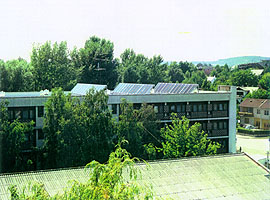Solar
Energy |
RENEWABLE
ENERGY
|
Solar Collectors in Hungary
In Hungary, as in all other former eastern-bloc countries, energy prices were subsidised. Prices were low and everybody thought that energy sources were endless. But as energy prices have risen dramatically, many people have started to look for ways of reducing their energy bills. Awareness of environmental problems is also growing. This means that the interest in energy efficiency and in use of renewable energy increased considerably in the last few years. The problem, however, is that it is expensive for an average family to invest in such installation and the payback period is too long (above 5 years). There is no cheap loan or governmental support for solar collectors.
Hungary has great potential for the use of solar energy, as the number of sunny hours in Hungary is between 1,950-2,150 per year at an intensity of 1,200 kWh/m2 per year. This amount of solar energy can provide a supply of hot water at 30-70oC from early spring until the end of the autumn, covering 60-70% of hot water need.
In spite of the lack of financial governmental support, in the last 4-5 years, more than 4,000 m2 of solar collectors have been installed by NGOs and commercial companies. More and more collectors are installed every year.
Most systems are for family houses, installed by commercial companies. A typical system consist of a 4 m2 solar collector and supplies 200 liters hot water per day when the sun is shining. This covers 60-70% of the yearly hot water demand for a family of 4 persons. It costs 1,000-2,000 USD and the pay back period is about 5-8 years.
Solar collectors are also increasingly popular at swimming pools and institutions like hospitals, camping, schools. At swimming pools it makes the water warmer and it expends the use of the pool with 3 months.
Several solar collector importing and manufacturing companies have appeared in the market. Presently there are 6 which are reporting success and increasing sale. Several of them started as joint ventures and later became fully Hungarian. At the beginning they mainly imported the solar collectors. Nowadays, most of them manufacture them in Hungary.
A new, special NGO initiative is the so-called "Kaláka"; a non-profit building method based on the Austrian "Do-It-Yourself" construction concept. This method decreases the installation costs by 50% compared to conventional ways. The Kaláka operates from 4 centres in Hungary:
- Pécs (Green Circle)
- Esztergom (Environmental Cultural Association)
- Nyíregyháza (EKA, Energy and Environment Foundation)
- Gömörszölös (Ecological Institue Foundation)
Each of these places has a workshop and "tool kits" for collector production. Anybody can attend these workshops and make their own collector with help from an expert. In addition, the workshop and its accessories are mobile, so it can be moved as needed. The installation can be done by anybody at home, with experts' assistance if required. Examples of the Kal ka projects are a 200-m2 solar collector system in the Ferences gymnasium in Esztergom and a 12-m2 demo-installation in the Eco-Garden island at Kis Duna.



| Contact address | Ökoszolgálat
(Eco-Service) Vadász utca 29, 1054 Budapest, Hungary. Ph/fax: +36-1-311-7855 E-mail: szolgak@okosz.zpok.hu Gusztáv Vágvölgyi and Erzsébet Pálfy, EKA (Kaláka
initiative) |
